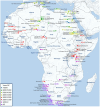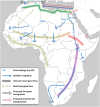History and genetic diversity of African sheep: Contrasting phenotypic and genomic diversity
- PMID: 39561986
- PMCID: PMC11666867
- DOI: 10.1111/age.13488
History and genetic diversity of African sheep: Contrasting phenotypic and genomic diversity
Abstract
Domesticated sheep have adapted to contrasting and extreme environments and continue to play important roles in local community-based economies throughout Africa. Here we review the Neolithic migrations of thin-tailed sheep and the later introductions of fat-tailed sheep into eastern Africa. According to contemporary pictorial evidence, the latter occurred in Egypt not before the Ptolemaic period (305-25 BCE). We further describe the more recent history of sheep in Egypt, the Maghreb, west and central Africa, central-east Africa, and southern Africa. We also present a comprehensive molecular survey based on the analysis of 50 K SNP genotypes for 59 African breeds contributed by several laboratories. We propose that gene flow and import of fat-tailed sheep have partially overwritten the diversity profile created by the initial migration. We found a genetic contrast between sheep north and south of the Sahara and a west-east contrast of thin- and fat-tailed sheep. There is no close relationship between African and central and east Asian fat-tailed breeds, whereas we observe within Africa only a modest effect of tail types on breed relationships.
Keywords: Africa; adaptation; fat tail; history; phylogeography; sheep; thin tail.
© 2024 The Author(s). Animal Genetics published by John Wiley & Sons Ltd on behalf of Stichting International Foundation for Animal Genetics.
Conflict of interest statement
We declare no competing financial interests.
Figures





References
-
- Achrati, A. (2003) The adorned ram of the rock art and al‐Karraz of the classical Arabic sources. Sahara, 14, 170.
-
- Adamu, M. (2005) Sahel type sheep breeds. In: Animal health and production compendium (AHPC). Oxfordshire, UK: CAB.
-
- Ahbara, A. , Bahbahani, H. , Almathen, F. , Al Abri, M. , Agoub, M.O. , Abeba, A. et al. (2019) Genome‐wide variation, candidate regions and genes associated with fat deposition and tail morphology in Ethiopian indigenous sheep. Frontiers in Genetics, 9, 699. Available from: 10.3389/fgene.2018.00699 - DOI - PMC - PubMed
Publication types
MeSH terms
LinkOut - more resources
Full Text Sources

